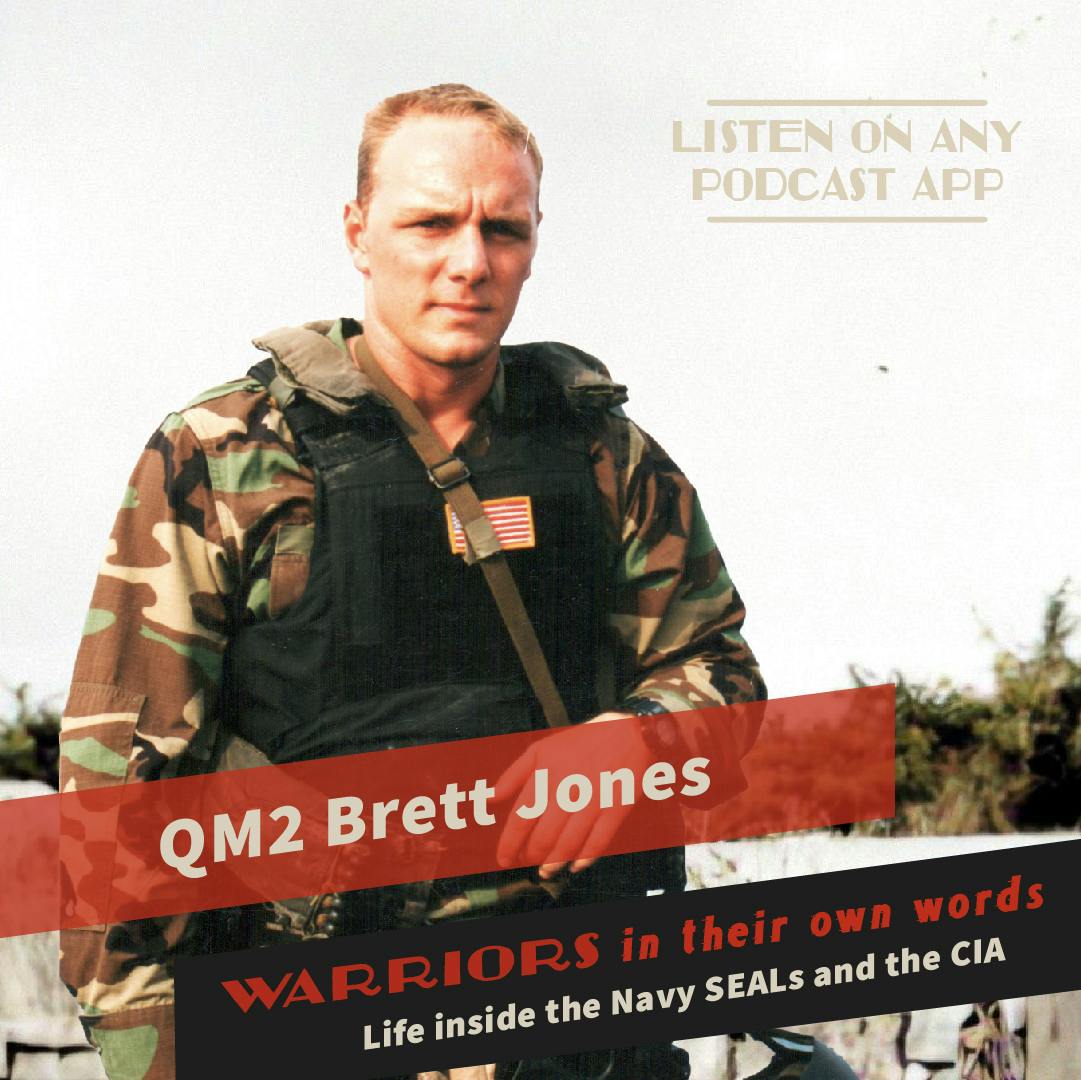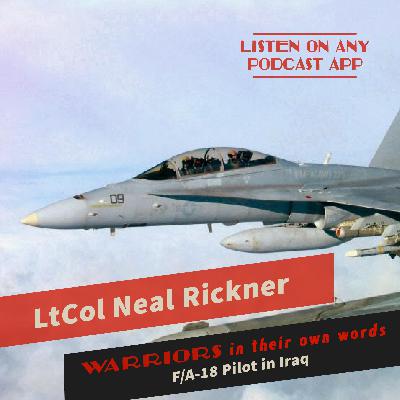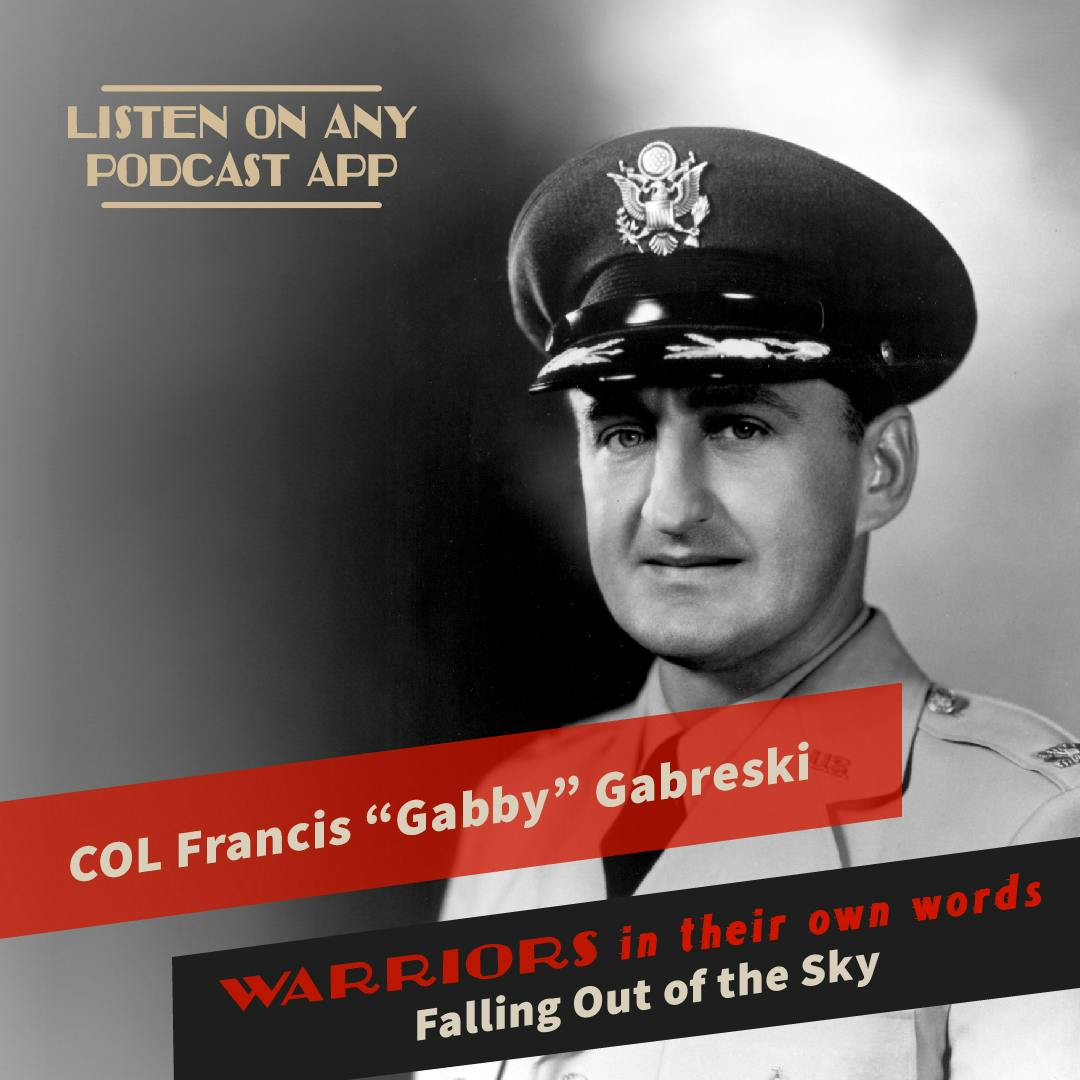Discover Warriors In Their Own Words | First Person War Stories
Warriors In Their Own Words | First Person War Stories

 Warriors In Their Own Words | First Person War Stories
Warriors In Their Own Words | First Person War Stories
Author: Evergreen Podcasts | The Honor Project
Subscribed: 1,934Played: 102,464Subscribe
Share
© The Honor Project
Description
The unsanitized truth of what we have asked of those who defend this nation. From archived tapes of WWI veterans, to conversations with modern-day warriors, these are their stories, in their own words.
253 Episodes
Reverse
QM2 Brett Jones joined the Navy in 1993 with the goal of becoming a Navy SEAL. Jones says he “wasn’t ready” the first time he went through SEAL training, and he did not complete the course. He came back and successfully completed the training on his second attempt.
Jones joined SEAL Team 8, the most active of all the SEAL teams, where he served abroad. Due to the covert nature of SEAL operations, Jones wasn’t able to share all the details of his engagements, but he does talk about missions in Iraq, and the pain of losing friends in combat.
After almost being kicked out of the SEALs, Jones decided to leave voluntarily. He continued to serve as a member of the CIA, deploying to Iraq again and protecting high value individuals in “high threat environments”.
Jones is now a part time police officer in Alabama.
Learn more about your ad choices. Visit megaphone.fm/adchoices
Colonel Leo Thorsness served as a fighter pilot in Vietnam. He was a Wild Weasel, whose missions required them to draw surface-to-air (SAM) missiles away from bombers, and then destroy the SAM sites. This meant that Weasels spent sometimes more than 20 minutes over the target, as opposed to the one or two minutes bomber pilots spent.
On one mission, COL Thorsness’ wingman was shot down, forcing him to eject. As he parachuted to the ground, rescue helicopters were called in to rescue him, but they were threatened by encroaching enemy fighters. Despite being incredibly low on fuel, Thorsness fought off the enemy, saving his wingman and the rescue helicopters.
Eleven days later, Thorsness was shot down and captured by the North Vietnamese Army. He was captured, and became a prisoner of war. During his first three years in captivity, torture was common. After six years, he was released and sent home.
Shortly after returning to the United States, COL Thorsness was awarded the Medal of Honor for saving his wingman.
Learn more about your ad choices. Visit megaphone.fm/adchoices
Colonel John Folsom served in the Marine Corps from 1980 to 2010. He was trained as a CH-46 helicopter pilot and a Forward Air Controller, but never flew combat missions. Instead he did staff work at various levels of command.
In this interview, Folsom gives an honest look into the lives of non-combat military personnel. He also talks about his work with the Dunham House, a unique assisted living facility for combat-wounded veterans.
Learn more about your ad choices. Visit megaphone.fm/adchoices
Lieutenant Commander Mike Smith served in the Navy as an F/A-18 pilot. He deployed 3 times between 2002 and 2014, and was stationed in Japan, Italy, Virginia, Mississippi, Texas, and Florida.
He was also Strike/Fighter Pilot of the Year in 2009.
Learn more about your ad choices. Visit megaphone.fm/adchoices
Lieutenant Colonel Neal Rickner served in the US Marine Corps as an F/A-18 pilot and a Forward Air Controller. He completed three tours in Iraq between 2003 and 2007.
As a Forward Air Controller (FAC), he toured with an infantry battalion, tasked with coordinating air support based on the needs of the battalion.
After coming back from deployment, Rickner served as an instructor pilot for the F/A-18.
Learn more about your ad choices. Visit megaphone.fm/adchoices
Technician Fifth Grade Clement Elissondo served in World War II as a tank gunner. He deployed to France just days after the Invasion of Normandy, and survived the destruction of four of his tanks.
In this interview, Elissondo describes the difficulties of tank warfare, narrowly escaping enemy capture, and the camaraderie amongst a tank’s crew.
Learn more about your ad choices. Visit megaphone.fm/adchoices
Captain Sidney Salomon served in World War II as an Army Ranger. The Rangers were an elite American unit that trained and operated with the famous British Commandos. Using the element of surprise as their main weapon, the Rangers played an important role in the Invasion of Normandy, the Dieppe Raid, and many other significant campaigns.
In this interview, Salomon describes his experiences on D-Day. He took part in the amphibious landing of Omaha Beach with 2nd Ranger Battalion, C Company. C Company was depicted at the beginning of ‘Saving Private Ryan’, when Captain Miller, played by Tom Hanks, led them through the landing.
It was Salomon’s job to storm the beach, climb a cliff, take a mortar position, and then storm a fortified house that held an automatic weapon. On the beach, Salomon was hit by shrapnel from a mortar explosion, and thought he was going to die. Thankfully the injury wasn’t that serious, and a medic was able to patch him up. Solomon continued up the cliff and successfully captured the German mortar position, but his unit suffered too many casualties to move onto the fortified house. They held that position until morning. Salomon was awarded a Silver Star for his actions on D-Day.
Learn more about your ad choices. Visit megaphone.fm/adchoices
Jim Beaver is an actor most widely known for his role as Bobby Singer in the TV series Supernatural. Before his acting career, Beaver served in Vietnam with the Marine Corps as a radio operator.
Learn more about your ad choices. Visit megaphone.fm/adchoices
Mal Middlesworth served in World War II in the Marine Corps. He was 17 years old during the Attack on Pearl Harbor, serving on a Marine Detachment on the USS San Francisco.
In this interview, he describes what he saw during Pearl Harbor, the Guadalcanal Campaign, and the Battle of Peleliu.
Learn more about your ad choices. Visit megaphone.fm/adchoices
Charles Sternburg served in the Navy in World War II with the Black Cats. The Black Cats were a group of bombers that flew stealth missions in the Pacific, tasked often with destroying enemy submarines or flying reconnaissance. They flew seaplanes called PBY Catalinas which were nearly invisible during the night, but were incredibly vulnerable to enemy munitions.
Sternburg flew as a co-pilot and bombardier with the Black Cats.
Learn more about your ad choices. Visit megaphone.fm/adchoices
Lieutenant General Charles D. Luckey served in the Army as an infantry officer, special forces officer (Green Beret), and a JAG officer. He retired as the oldest Green Beret in uniform.
In this interview, Luckey tells stories from his service, and what he learned about leadership during his career.
Learn more about your ad choices. Visit megaphone.fm/adchoices
Commander Jon Macaskill served in Afghanistan as a Navy SEAL. He graduated from the Naval Academy, and served in the SEAL teams from 2003 to 2020.
Learn more about your ad choices. Visit megaphone.fm/adchoices
Samuel Fine served as a glider pilot in World War II. He trained British Glider pilots, and flew in with them during the Invasion of Sicily. Fine also flew troops into D-Day & Operation Market Garden.
Learn more about your ad choices. Visit megaphone.fm/adchoices
Hi, I’m Ken Harbaugh, host of Warriors In Their Own Words. In order to gear up for some exciting new episodes, we’re taking a break this week. In the meantime, I wanted to share an episode from another podcast I think you’ll enjoy. Unsolved Histories explores forgotten mysteries and other little-known stories. The episode I’m sharing with you covers missing flight 293, where 101 people disappeared with no distress call. This multi-part story they covered in season 1 was so impactful that it directly resulted in Congress passing new legislation.
Here is Flight 293 Episode One: Brothers.
--
The Unsolved Histories podcast team was pleased to get a phone call letting us know a U.S. senator not only listened to Season 1 but wanted to address a problem raised by our recounting of the tragic story of Flight 293. Military men and women who go missing, but not in action, are not remembered or memorialized and the families left without the support that is given to other MIA families. If passed, the Flight 293 Remembrance Act will change that. Host Feliks Banel researched this and other accidents involving service members who seemed to be forgotten by the government they served. Here’s a clip from episode one of Unsolved Histories: What Happened to Flight 293?
For more information, including pictures and all episodes, see our website, unsolvedhistoriespod.com
Learn more about your ad choices. Visit megaphone.fm/adchoices
Major Robert Prince served as an Army Ranger during World War II. He fought throughout the Phillippines, and helped plan the Raid on Cabanatuan, a Japanese POW camp.
With the help of Filipino civilians, the Rangers, Alamo Scouts and guerilla forces traveled 24 miles under the cover of darkness to launch a surprise attack on the camp. They successfully defeated the Japanese and liberated over 500 prisoners of war.
Actor James Franco portrayed MAJ Prince in The Great Raid (2005), which tells the story of Cabanatuan.
Learn more about your ad choices. Visit megaphone.fm/adchoices
Corporal Roy Roush served in the United States Marine Corps during World War II. He fought in the Guadalcanal Campaign, the Battle of Tarawa, the Battle of Saipan, and the Battle of Tinian.
He later served in the Air Force as a fighter pilot during the Korean War.
In this interview, Roush describes his experiences during the Battle of Saipan & the Battle of Tinian
To learn more about Roush, check out his book, Open Fire.
Learn more about your ad choices. Visit megaphone.fm/adchoices
Corporal Roy Roush served in the United States Marine Corps during World War II. He fought in the Guadalcanal Campaign, the Battle of Tarawa, the Battle of Saipan, and the Battle of Tinian.
He later served in the Air Force as a fighter pilot during the Korean War.
In this interview, Roush describes the Battle of Tarawa.
To learn more about Roush, check out his book, Open Fire.
Learn more about your ad choices. Visit megaphone.fm/adchoices
Colonel Francis Gabreski served in World War II as a fighter pilot. He flew bomber escort missions with the 56th Fighter Group in the P-47 Thunderbolt, and was the top U.S. fighter ace in the European theater. He’s credited with destroying 34 ½ enemy aircraft in combat, and is one of only seven American pilots to become an ace in two wars (WWII & Korea).
Learn more about your ad choices. Visit megaphone.fm/adchoices
Chief Petty Officer Otto Carl Schwarz Jr. served in the Navy in World War II. He was born in the Netherlands, but moved to the US with his family during childhood. He enlisted in the US Navy in January 1941 with the permission of his parents.
Schwarz served stints on several ships before making his way to the USS Houston, a heavy cruiser, in June 1941.
During the Battle of Sunda Strait in February 1942, the Houston was sunk by enemy torpedoes and gunfire. Those who escaped the Houston came under machine gun fire from the Japanese as they floated in the water. In total, 700 men were lost.
Like most of the 368 men who survived, Schwarz was captured by the Japanese and sent to a work camp. He was transported via a “Hell ship”.
Hell ships earned their moniker from the allied prisoners of war who were unlucky enough to board one. They were requisitioned merchant ships that were extremely overcrowded with POWs. Described as “floating dungeons”, inmates had “no access to the air, space, light, bathroom facilities, and adequate food or water.” You can learn more about them here.
Schwarz was first sent to Bicycle Camp, a POW camp in modern day Indonesia. There he experienced the best treatment during his time as a prisoner, but it didn’t last long. He was transferred to Changi Prison in Singapore, and then to a prison camp in Moulmein, Burma.
There he was forced to work on the Burma Railway, also known as the Death Railway. According to Britannica “More than 11 percent of civilian internees and 27 percent of Allied POWs died or were killed while in Japanese custody; by contrast, the death rate for Allied POWs in German camps was around 4 percent.” Over 60,000 allies were forced to build it, and over 10,000 died during its construction.
Conditions for these POWs were unfathomable. They were underfed and overworked, they suffered from numerous diseases and illnesses, they were given little to no medical attention, they faced harsh weather conditions, they had to deal with insect infestations, and they were often subjected to beatings by their captors.
Learn more about your ad choices. Visit megaphone.fm/adchoices
Captain Tom “Bear” Wilson served in Vietnam as an Electronic Warfare Officer (EWO). He sat in the back seat of aircraft, and was responsible for monitoring radar in order to warn his pilot of threats, like surface-to-air missiles (SAMs), anti-aircraft artillery, and enemy aircraft. He also protected his aircraft by jamming enemy radar.
As a Wild Weasel, it was Wilson’s job to protect friendly aircraft attacking enemy SAM sites, who have one of the most dangerous jobs in modern warfare. Wilson and his front seater drew SAMs away from bombers, and targeted the SAM sites themselves. This meant that Weasels spent sometimes more than 20 minutes over the target, as opposed to the one or two minutes bomber pilots spent.
One of our favorite interviews features another Wild Weasel and MOH recipient named Col. Leo Thorsness. Check it out here.
Learn more about your ad choices. Visit megaphone.fm/adchoices















Thank you Sir
it's takes a Super Soldier to survive and complete all you have done ! Thanks for Giving All for our great Nation
Ojeda ran for Congress in WV, but because he ran as a Democrat, he didn't stand much of a chance. It's clear listening to him that he would have been a hands-on leader for his constituents and not a typical bagman for big business.
🔴✅📺📱💻ALL>Movies>WATCH>ᗪOᗯᑎᒪOᗩᗪ>LINK>👉https://co.fastmovies.org
If everything constantly seems "surreal," then one's initial impressions of reality were flawed, not the reality confronted.
I remember that shameful incident of cutting the Lt. Col. mic, and how on the web, many conservatives defended the act, simply because they couldn't tolerate actual history. That they refused to learn that freed slaves appreciated the sacrifice and wanted to honor it, and instead wanted to erase these blacks was a forebear to the disrespect now flourishing thanks to Trump. Thanks for including this fine address in the podcast.
This is the greatest Bullshit podcast ever!🤣🤣🤣 listen closely people.
Great anecdotal fiction. This man "observed " and "heard" alot about other peoples' experiences that's for sure.
schillettv here.. best podcast out
Love this podcast
1 of my favorite p. cast
How do I find the other podcasts. only 40 shown in my podcatcher. they are numbered up to 220 though. I would like to know where to get the others.
great stories, listen all the time
very interesting
580%????? 100% would mean all tanks.
the dad story at the end is the BEST
no updates?????
this is a fantastic podcast